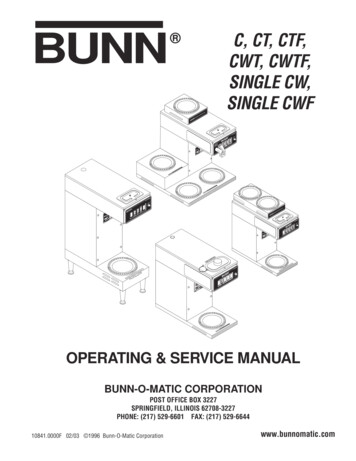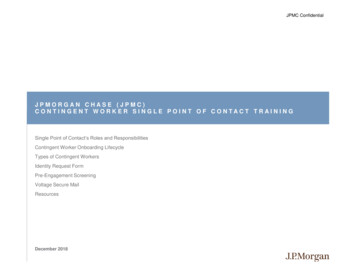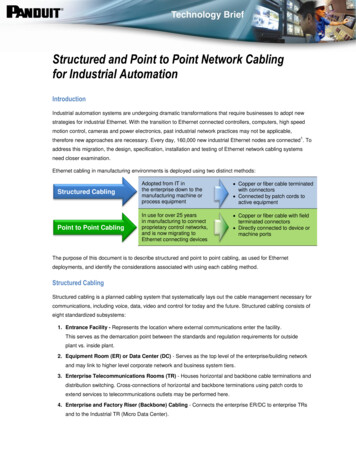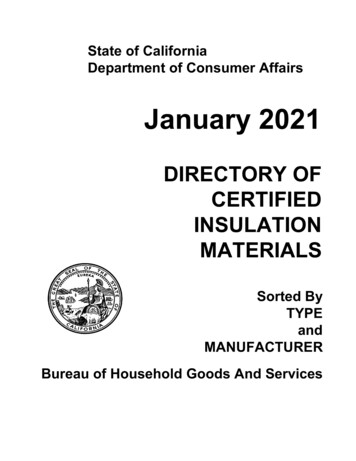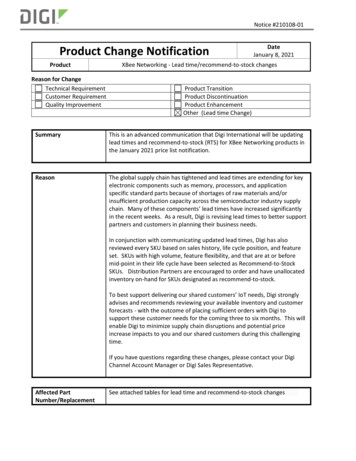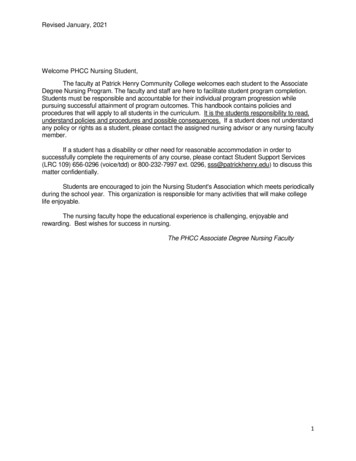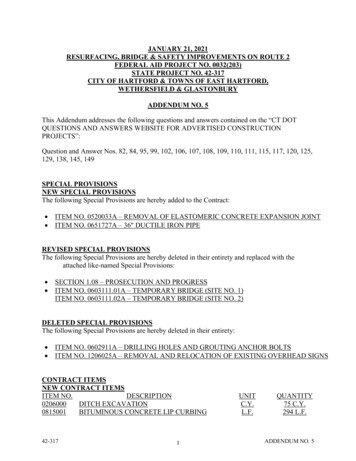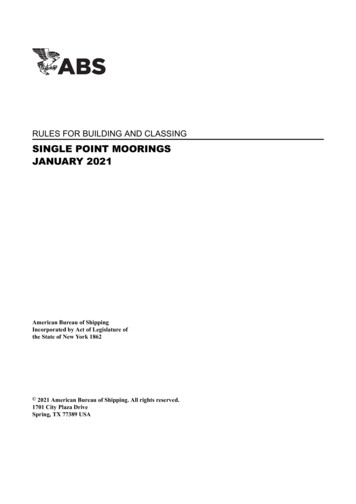
Transcription
RULES FOR BUILDING AND CLASSINGSINGLE POINT MOORINGSJANUARY 2021American Bureau of ShippingIncorporated by Act of Legislature ofthe State of New York 1862 2021 American Bureau of Shipping. All rights reserved.1701 City Plaza DriveSpring, TX 77389 USA
ForewordThis edition of the ABS Rules for Building and Classing Single Point Moorings (SPMs) primarily reflectschanges in format and references to ABS and other standards that have occurred since the previous editionwas issued.Changes to the technical criteria include revisions made to other pertinent ABS Rules that are the basis ofSPM criteria; such as, the introduction of an adjustment factor (Q) to account for higher strength steels inthe determination of buoy scantlings. Also the section on Moorings and Anchoring Section (3-4-1, herein)has been updated to reflect industry practice and to specifically allow the option to use the criteria found inthe ABS Rules for Building and Classing Floating Production Installations for this topic.PART 1 (1 January 2008)For the 2008 edition, Part 1, "Conditions of Classification" was consolidated into a generic booklet,entitled Rules for Conditions of Classification – Offshore Units and Structures (Part 1) for all vessels otherthan those in offshore service. The purpose of this consolidation was to emphasize the commonapplicability of the classification requirements in "Part 1" to ABS-classed vessels, other marine structuresand their associated machinery, and thereby make "Conditions of Classification" more readily a commonRule of the various ABS Rules and Guides, as appropriate.Thus, this supplement specifies only the unique requirements applicable to single point moorings. Thissupplement is always to be used with the aforementioned Rules for Conditions of Classification – OffshoreUnits and Structures (Part 1).ABS RULES FOR BUILDING AND CLASSING SINGLE POINT MOORINGS 2021ii
RULES FOR BUILDING AND CLASSINGSINGLE POINT MOORINGSCONTENTSPART 1Conditions of Classification. 1CHAPTER 1Scope and Conditions of Classification. 1PART 2Materials and Welding. 10CHAPTER 1. 11PART 3Mooring System Design. 13CHAPTER 1General. 14CHAPTER 2Design.25CHAPTER 3Stability. 48CHAPTER 4Equipment.50PART 4Equipment and Systems. 54Cargo or Product Transfer Systems. 55Ancillary Systems and Equipment. 63Hazardous Areas and Electrical Installations. 65Safety Provisions. 69CHAPTER 1CHAPTER 2CHAPTER 3CHAPTER 4PART 5Testing and Surveys. 71Tesing During Construction.72Surveys After Construction. 77CHAPTER 1CHAPTER 2ABS RULES FOR BUILDING AND CLASSING SINGLE POINT MOORINGS 2021iii
PART1Conditions of ClassificationCONTENTSCHAPTER 1Scope and Conditions of Classification. 1Section 1Classification (1 January 2008). 2Section 2Classification Symbols and Notations.3Section 3Rules for Classification (1 January 2008). 5Section 4Plans and Design Data to be Submitted .6Section 5Information Booklet and Maintenance Manual. 9ABS RULES FOR BUILDING AND CLASSING SINGLE POINT MOORINGS 20211
This Page Intentionally Left Blank
PART1CHAPTER1Scope and Conditions of ClassificationCONTENTSSECTION1Classification (1 January 2008). 2SECTION2Classification Symbols and Notations.31Single Point Moorings Built Under Survey (2014). 31.1General. 31.3Modified Scope to Exclude PLEM. 31.5Unconventional Designs. 33Single Point Moorings Not Built Under Survey. 45Single Point Mooring as a Part of a Floating ProductionSystem (2011).47Classification Data. 4SECTION3Rules for Classification (1 January 2008).51Application of Rules. 5SECTION4Plans and Design Data to be Submitted . 61Plans.63Site Chart.75Site Condition Reports.77Model Tests.79Calculations. 711Additional Plans. 713Submissions (2011). 8SECTION5Information Booklet and Maintenance Manual. 91Items Included in Information Booklet and MaintenanceManual. 9ABS RULES FOR BUILDING AND CLASSING SINGLE POINT MOORINGS 20211
PART1CHAPTER1Scope and Conditions of ClassificationSECTION1Classification (1 January 2008)The requirements for conditions of classification are contained in the separate, generic ABS Rules forConditions of Classification – Offshore Units and Structures (Part 1).Additional requirements specific to single point moorings are contained in the following portions Sectionsof this Chapter.ABS RULES FOR BUILDING AND CLASSING SINGLE POINT MOORINGS 20212
PART1CHAPTER1Scope and Conditions of ClassificationSECTION2Classification Symbols and NotationsA listing of Classification Symbols and Notations available to the Owners of vessels, offshore drilling andproduction units and other marine structures and systems, “List of ABS Notations and Symbols” isavailable from the ABS website “http://www.eagle.org”.1Single Point Moorings Built Under Survey (2014)1.1General (2021)SPM’s which have been built under the supervision of the ABS Surveyors to the requirements of theseRules or to their equivalent, where approved by the Classification Committee, will be classed anddistinguished in the Record by the symbols A1Single Point Mooring. This document is mainlyapplicable to SPM systems which are designed for temporarily moored vessels. For vessels which will bepermanently moored to a SPM, the ABS Rules for Building and Classing Floating Production Installations(FPI Rules) applies. Data as described in 1-1-2/7 will be indicated in the Record.Where design fatigue life values are specified by the applicant for the position mooring system and thedesign complies with the fatigue requirements of the ABS Guide for Position Mooring Systems, thenotation FLM (number of years), Year, where (number of years) refers to the target value of thefatigue life for a new position mooring system and Year refers to the year of maturation associated withthe new position mooring system will be applied. Where an existing mooring system is to be reused, thenotation RFLM (number of years), Year referring to the remaining fatigue life of the existing positionmooring system will apply.1.3Modified Scope to Exclude PLEMWhen requested by the Owner and agreed to by ABS; the Pipeline End Manifold, PLEM, (or similarequipment) associated with the SPM may be exempted from the scope of Classification. The manner usedto control the flow of fluid between a subsea pipeline and the visiting vessel is to be fully described indocumentation provided to ABS when requesting this exemption. As appropriate, the ClassificationDesignation used when the PLEM is excluded from the scope of classification is Single Point Mooring(excl. PLEM). The following portions of these Rules will not apply when the PLEM is excluded from thescope of classification: 3-2-2/17, 4-1-4/9 and items pertinent to the PLEM in 5-1-1/11.3 TABLE 2. It is theOwner’s responsibility to verify that the exclusion of the PLEM from ABS design review and survey isacceptable to the governmental authority having jurisdiction over the SPM.1.5Unconventional DesignsThese Rules apply to conventional SPM designs. A conventional SPM provides temporary offshoremooring to a variety of visiting vessels by means of a hawser or yoke from the buoy or fixed tower. Fluidtransfer between the visiting vessel and a sea floor pipeline is performed by an underbuoy hose or riser,and a hose between the buoy or tower and the visiting vessel.An example of a mooring system design that differs from the above concept is one characterized as adetachable turret-type system. In this case the visiting vessel has a unique mating assembly used to join thebuoy and the vessel. The mating assembly may be located inside the hull of the visiting vessel, or theassembly may be mounted externally at an end of the vessel. Fluid flow may occur through jumper hosesor piping between the buoy and vessel. The applicability of these Rules to an unconventional design willABS RULES FOR BUILDING AND CLASSING SINGLE POINT MOORINGS 20213
PartChapterSection112Conditions of ClassificationScope and Conditions of ClassificationClassification Symbols and Notations1-1-2be decided by ABS on a case-by-case basis. In such a case, the criteria in these Rules may need to besupplemented or replaced by criteria in the FPI Rules.3Single Point Moorings Not Built Under SurveySPM’s which have not been built under the supervision of the ABS Surveyors, but which are submitted forclassification, will be subject to a special classification survey. Where found satisfactory, and thereafterapproved by the Classification Committee, they will be classed and distinguished in the Record in themanner as described as in 1-1-2/1 but the mark “ ” signifying the survey during construction will beomitted.5Single Point Mooring as a Part of a Floating Production System(2011)SPM’s built under survey for use as part of the mooring system for a classed floating production system donot require a separate classification under these Rules. Requirements for mooring systems of floatingproduction systems are found in the FPI Rules.7Classification DataData on single point moorings will be published in the Record as to the latitude and longitude of thelocation of the mooring, the length overall and displacement of the ship it is designed to moor, the depth ofwater at the site, maximum hawser tension where applicable, and general types of cargo and other fluidswhich the mooring is designed to handle.ABS RULES FOR BUILDING AND CLASSING SINGLE POINT MOORINGS 20214
PART1CHAPTER1Scope and Conditions of ClassificationSECTION3Rules for Classification (1 January 2008)1Application of RulesThese Rules are applicable to unmanned SPM’s as defined in Section 3-1-1 and are generally intended fortemporary moored vessels.These Rules are applicable to those features of the system that are permanent in nature and can be verifiedby plan review, calculation, physical survey or other appropriate means. Any statement in the Rulesregarding other features is to be considered as a guidance to the designer, builder, owner, et al.ABS RULES FOR BUILDING AND CLASSING SINGLE POINT MOORINGS 20215
PART1CHAPTER1Scope and Conditions of ClassificationSECTION4Plans and Design Data to be Submitted1PlansPlans showing the scantlings, arrangements, and details of the principal parts of the structure, associatedpiping and equipment of each SPM to be built under survey are to be submitted for review and approvedbefore construction is commenced. These plans are to clearly indicate the scantlings, joint details andwelding, or other methods of connection. The number of copies to be submitted is to be in accordance with1-1-4/11 and 1-1-4/13. In general, plans are to include the following where applicable. General arrangement An arrangement plan of watertight compartmentation, including the location, type and disposition ofwatertight and weathertight closures Structural arrangement showing shell plating, framing, bulkheads, flats, main and bracing members,joint details, as applicable Details of watertight doors and hatches Welding details and procedures Corrosion control arrangements Type, location and amount of permanent ballast, if any Bilge, sounding and venting arrangements Hazardous areas Electrical system one line diagrams Location of fire safety equipment Mooring arrangement Mooring components including anchor legs, associated hardware, hawser(s), and hawser loaddeflection characteristics Foundations for mooring components, industrial equipment, etc. showing attachments to hull structure Anchoring system showing the size of anchor, holding capacity of piles, pile sizes, and capacity, etc. Pipe Line End Manifold (PLEM) as applicable SPM main bearing Cargo or product swivel including swivel driving mechanism, swivel bearings, and electrical swiveldetails Product or cargo system piping schematic drawing with bill of materials Design data of equipment, piping and related components including minimum and maximum designpressure and temperature Ancillary piping systems schematic drawings with bills of material Floating and underbuoy hoses/flexible risersABS RULES FOR BUILDING AND CLASSING SINGLE POINT MOORINGS 20216
PartChapterSection3114Conditions of ClassificationScope and Conditions of ClassificationPlans and Design Data to be Submitted1-1-4 Telemetry/Control system Navigation aids Methods and locations for nondestructive testing (NDT) Plans for conducting underwater inspections in lieu of drydocking Test and inspection plan for all major load carrying or pressure retaining components including cargoor product swivel, electrical swivel, bearings. Test ProceduresSite ChartTo demonstrate that navigational considerations have been taken into account in establishing the mooringlocation, a site chart of the mooring area is to be submitted in accordance with Section 3-1-2 which showsthe location of the mooring, potential navigation hazards and existing and planned navigation aids, bottomcontour elevations, maneuvering area and swing circle.5Site Condition ReportsTo demonstrate that site conditions have been ascertained and taken into consideration in establishingdesign criteria, reports on subjects including the following are to be submitted in accordance with Section3-1-2.7i)Environmental conditions of wind, waves, current, seiche, tide, visibility, temperature, and ice.ii)Water depth, at berth and throughout the maneuvering area, bottom soil conditions, and subsurfacehazards.Model TestsWhen model tests are used to determine the design loads or to demonstrate that the established designloads have been based on the results of physical dynamic model tests, a report is to be submitted describingthe design loads, calculations, description of model test facilities and procedures, and a summary of theresults. It is recommended that the designer consult with ABS concerning model testing, procedures,methods and data analysis to ensure the investigation is adequate.9CalculationsIn general, where applicable, the following calculations are to be submitted:i)Structural design in accordance with Section 3-2-2ii)Stability calculations in accordance with Section 3-2-2iii)Mooring and anchorage in accordance with Section 3-4-1iv)Piping in accordance with Part 4, Chapters 1 and 2v)Calculations for all pressure retaining and load bearing components in accordance with Part 4vi)Swivel stack static and dynamic analysis in accordance with Part 4Calculations when submitted are to be footnoted indicating references.11Additional PlansWhere certification under the other regulations described in Section 1-1-5 of the ABS Rules for Conditionsof Classification – Offshore Units and Structures (Part 1) is requested, submission of additional plans andcalculations may be required.ABS RULES FOR BUILDING AND CLASSING SINGLE POINT MOORINGS 20217
PartChapterSection13114Conditions of ClassificationScope and Conditions of ClassificationPlans and Design Data to be Submitted1-1-4Submissions (2011)Plans should generally be submitted electronically to ABS. However, hard copies will also be accepted.Additional copies may be required when the required attendance of the Surveyor is anticipated at multiplelocations.All plan submissions originating from manufacturers are understood to have been made with thecognizance of the builder.ABS RULES FOR BUILDING AND CLASSING SINGLE POINT MOORINGS 20218
PART1CHAPTER1Scope and Conditions of ClassificationSECTION5Information Booklet and Maintenance ManualFor each SPM, a document is to be submitted. This document is to include recommendations regardingoperation and maintenance of the SPM facility, the design criteria for the SPM, information regarding themooring area, and the components of the SPM.1Items Included in Information Booklet and Maintenance ManualThe document is to include the following information.i)Site chart as described in 1-1-4/3ii)Design vessel data, including deadweight, length, draft and distance from bow to manifold.iii)Environmental design criteria with various sizes of vessels, including the operating wind, wave,current and tides.iv)Design cargo transfer criteria, including type of cargo and design maximum. working pressure,temperature, flow rate, and minimum valve closing times including the vessel’s manifold valves.v)Plans showing the general arrangement of the single point mooring components and details ofthose components required to be handled during operation or inspected during maintenance,including details of access to these components.vi)Description of navigation aids and safety features.vii)Recommended procedure for the mooring and disconnecting a vessel at the SPM.viii)Recommended procedure for connecting and disconnecting floating hose to a tanker’s manifold.ix)Recommended maintenance schedule and procedures for the SPM facilities, including a check listof items recommended for periodic inspection. Where applicable, procedures for adjusting anchorleg tension, removal and reinstallation of hoses, inspection of flexible risers, adjustment ofbuoyancy tanks, and replacement of seals in the cargo swivel are to be included.x)Recommended cargo system pressure testing.The Information Booklet and Maintenance Manual is to be submitted for review by ABS solely to ensurethe presence of the above information which is to be consistent with the design information and limitationsconsidered in the SPM’s classification. ABS is not responsible for the operation of the SPM.The Information Booklet and Maintenance Manual required by these Rules may contain informationrequired by flag and coastal Administrations. These Administrations may require that additionalinformation be in
When requested by the Owner and agreed to by ABS; the Pipeline End Manifold, PLEM, (or similar equipment) associated with the SPM may be exempted from the scope of Classification. The manner used to control the flow of fluid between a subsea pip
